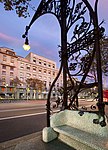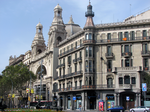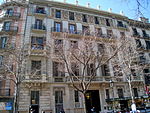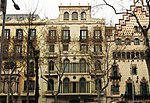Passeig de Gràcia station

Passeig de Gràcia is an underground railway and metro station in Barcelona located under Passeig de Gràcia, in Eixample district. It is one of the Barcelona's busiest railway stations and important stop for Barcelona Metro network. It is served by Rodalies de Catalunya suburban railway lines R2 and regional lines R11, R13, R14, R15 and R16, and it is also served by TMB-operated Barcelona Metro lines L2, L3 and L4. Passeig de Gràcia station should not be confused with Gràcia station, which is located some 1.7 kilometres (1.1 mi) away on metro lines L6 and L7, and various other Ferrocarrils de la Generalitat de Catalunya lines. The station includes an artwork entitled Ballarins nus by Angel Orensanz.
Excerpt from the Wikipedia article Passeig de Gràcia station (License: CC BY-SA 3.0, Authors, Images).Passeig de Gràcia station
Passeig de Gràcia, Barcelona
Geographical coordinates (GPS) Address Nearby Places Show on map
Geographical coordinates (GPS)
| Latitude | Longitude |
|---|---|
| N 41.39 ° | E 2.1677777777778 ° |
Address
Pg de Gràcia - Gran Via
Passeig de Gràcia
08001 Barcelona
Catalonia, Spain
Open on Google Maps










